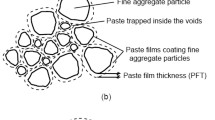Abstract
The packing characteristics of the cementitious materials have great influence on the performance of a concrete mix, but there is so far no generally accepted method of measurement. Herein, a new method, called the wet packing method, is developed. It mixes the cementitious materials with water and then measures the apparent density and voids content of the resulting mixture at varying water/cementitious materials ratio to characterise the packing behaviour of the cementitious materials. Trial mixing and testing revealed that the mixing procedure is crucial to the success of the test method. To ensure thorough mixing within a reasonable time, a special mixing procedure is adopted. Using this method, the packing characteristics of pure cement and blended cementitious materials under different conditions have been measured. Based on the results so obtained, it is advocated that the packing density and water demand should be measured directly using a wet packing method rather than indirectly by any consistence test because the water content at any preset consistence is not necessarily the same as the minimum water content needed to fill up the voids. Some useful applications of the new method are illustrated in Part 2 of this paper.






Similar content being viewed by others
References
Powers TC (1968) The properties of fresh concrete. John Wiley & Sons, New York
DeLarrard F, Sedran T (1994) Optimization of ultra-high-performance concrete by the use of a packing model. Cem Concr Res 24(6):997–1009
Richard P, Cheyrezy M (1995) Composition of reactive powder concretes. Cem Concr Res 25(7):1501–1511
Sedran T, DeLarrard F, Hourst F, Contamines C (1996) Mix design of self-compacting concrete. In: Bartos PJM et al (eds) Proceedings of the international RILEM conference on production methods and workability of concrete. Paisley, Scotland, pp 439–450
Lange F, Mörtel H, Rudert V (1997) Dense packing of cement pastes and resulting consequences on mortar properties. Cem Concr Res 27(10):1481–1488
Jones MR, Zheng L, Newlands MD (2003) Estimation of the filler content required to minimize voids ratio in concrete. Mag Concr Res 55(2):193–202
Reed JS (1995) Principles of ceramics processing. John Wiley & Sons, New York
British Standards Institution (1995) BS 812 Testing of aggregates part 2: method of determination of density. BSI, London
Svarovsky L (1987) Powder testing guide: methods of measuring the physical properties of bulk powders. Elsevier Applied Science Publishers Ltd, England
Yu AB, Bridgwater J, Burbidge A (1997) On the modeling of the packing of fine particles. Powder Technol 92(3):185–194
Pietsch W (1997) Size enlargement by agglomeration. In: Fayed ME, Otten L (eds) Handbook of powder science and technology, 2nd edn. Chapman & Hall, New York
British Standards Institution (1995) BS EN 196 Methods of testing cement part 3: determination of setting time and soundness. BSI, London
Dewar JD (1999) Computer modelling of concrete mixtures. E & FN Spon, London
Bigas JP, Gallias JL (2002) Effect of fine mineral additions on granular packing of cement mixtures. Mag Concr Res 54(3):155–164
DeLarrard F (1999) Concrete mixture proportioning: a scientific approach. E & FN Spon, London
Iveson SM, Litster JD, Hapgood K, Ennis BJ (2001) Nucleation, growth and breakage phenomena in agitated wet granulation processes: a review. Powder Technol 117(1–2):3–39
Schaafsma SH, Vonk P, Segers P, Kossen NWF (1998) Description of agglomerate growth. Powder Technol 97(3):189–190
Iveson SM, Wauters PAL, Forrest S, Lister JD, Meesters GMH, Scarlett B (2001) Growth regime map for liquid-bound granules: further development and experimental validation. Powder Technol 117(1–2):83–97
British Standards Institution (1978) BS 4550 Methods of testing cement part 3: physical tests. BSI, London
Zou RP, Yu AB (1996) Evaluation of the packing characteristics of mono-sized non-spherical particles. Powder Technol 88(1):71–79
Kwan AKH, Mora CF (2001) Effects of various shape parameters on packing of aggregate particles. Mag Concr Res 53(2):91–100
Acknowledgement
The work described in this paper was fully supported by a grant from the Research Grants Council of the Hong Kong Special Administrative Region, China (Project No. HKU 7139/05E).
Author information
Authors and Affiliations
Corresponding author
Rights and permissions
About this article
Cite this article
Wong, H.H.C., Kwan, A.K.H. Packing density of cementitious materials: part 1—measurement using a wet packing method. Mater Struct 41, 689–701 (2008). https://doi.org/10.1617/s11527-007-9274-5
Received:
Accepted:
Published:
Issue Date:
DOI: https://doi.org/10.1617/s11527-007-9274-5




